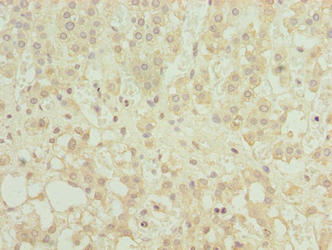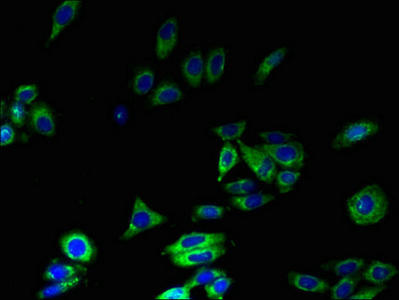Description
| Antibody Name: | MFSD8 Antibody (PACO39166) |
| Antibody SKU: | PACO39166 |
| Size: | 50ug |
| Host Species: | Rabbit |
| Tested Applications: | ELISA, IHC, IF |
| Recommended Dilutions: | ELISA:1:2000-1:10000, IHC:1:20-1:200, IF:1:50-1:200 |
| Species Reactivity: | Human |
| Immunogen: | Recombinant Human Major facilitator superfamily domain-containing protein 8 protein (1-40AA) |
| Form: | Liquid |
| Storage Buffer: | Preservative: 0.03% Proclin 300 Constituents: 50% Glycerol, 0.01M PBS, PH 7.4 |
| Purification Method: | >95%, Protein G purified |
| Clonality: | Polyclonal |
| Isotype: | IgG |
| Conjugate: | Non-conjugated |
 | Immunohistochemistry of paraffin-embedded human adrenal gland tissue using PACO39166 at dilution of 1:100. |
 | Immunofluorescent analysis of HepG2 cells using PACO39166 at dilution of 1:100 and Alexa Fluor 488-congugated AffiniPure Goat Anti-Rabbit IgG(H+L). |
| Background: | May be a carrier that transport small solutes by using chemiosmotic ion gradients. |
| Synonyms: | Major facilitator superfamily domain-containing protein 8 (Ceroid-lipofuscinosis neuronal protein 7), MFSD8, CLN7 |
| UniProt Protein Function: | MFSD8: May be a carrier that transport small solutes by using chemiosmotic ion gradients (Potential). Defects in MFSD8 are the cause of neuronal ceroid lipofuscinosis type 7 (CLN7). A form of late infantile neuronal ceroid lipofuscinosis. CNL are a clinically and genetically heterogeneous group of neurodegenerative disorders characterized by the intracellular accumulation of autofluorescent lipopigment storage material in different patterns ultrastructurally. The patterns most often observed CLN7 are mixed combinations of granular, curvilinear, fingerprint, and rectilinear profiles. The clinical course includes progressive dementia, seizures, and progressive visual failure. Belongs to the major facilitator superfamily.Protein type: Membrane protein, multi-pass; Membrane protein, integralChromosomal Location of Human Ortholog: 4q28.2Cellular Component: nucleoplasm; intracellular membrane-bound organelle; lysosomal membrane; integral to membraneBiological Process: lysosome organization and biogenesis; transmembrane transportDisease: Ceroid Lipofuscinosis, Neuronal, 7; Macular Dystrophy With Central Cone Involvement |
| UniProt Protein Details: | |
| NCBI Summary: | This gene encodes a ubiquitous integral membrane protein that contains a transporter domain and a major facilitator superfamily (MFS) domain. Other members of the major facilitator superfamily transport small solutes through chemiosmotic ion gradients. The substrate transported by this protein is unknown. The protein likely localizes to lysosomal membranes. Mutations in this gene are correlated with a variant form of late infantile-onset neuronal ceroid lipofuscinoses (vLINCL). [provided by RefSeq, Oct 2008] |
| UniProt Code: | Q8NHS3 |
| NCBI GenInfo Identifier: | 22749525 |
| NCBI Gene ID: | 256471 |
| NCBI Accession: | NP_689991.1 |
| UniProt Secondary Accession: | Q8NHS3,Q8N2P3, B2RDM1 |
| UniProt Related Accession: | Q8NHS3 |
| Molecular Weight: | 57,628 Da |
| NCBI Full Name: | major facilitator superfamily domain-containing protein 8 |
| NCBI Synonym Full Names: | major facilitator superfamily domain containing 8 |
| NCBI Official Symbol: | MFSD8 |
| NCBI Official Synonym Symbols: | CLN7 |
| NCBI Protein Information: | major facilitator superfamily domain-containing protein 8; ceroid-lipofuscinosis, neuronal 7, late infantile |
| UniProt Protein Name: | Major facilitator superfamily domain-containing protein 8 |
| UniProt Synonym Protein Names: | Ceroid-lipofuscinosis neuronal protein 7 |
| Protein Family: | Major facilitator superfamily domain-containing protein |
| UniProt Gene Name: | MFSD8 |
| UniProt Entry Name: | MFSD8_HUMAN |






